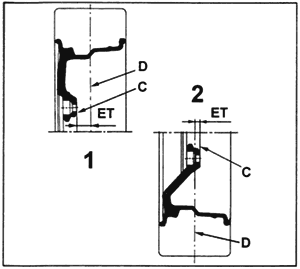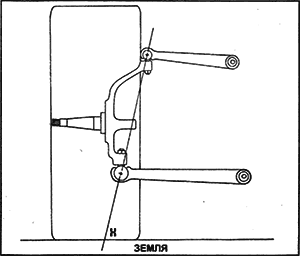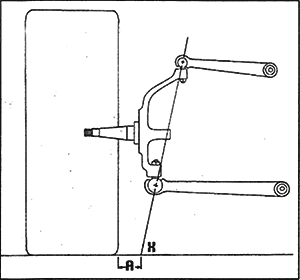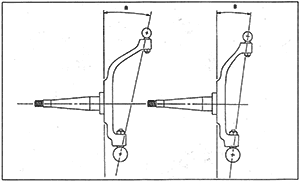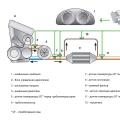Almost all sports cars front wheels are installed with negative camber, the only question is how much to set this camber. Often high-speed cars are performed with large negative camber because it is expected to help improve handling, especially when cornering. The negative camber provided by the front suspension improves the position of one wheel relative to the road. It could be left front wheel in a right turn or right wheel in the left turn. This wheel has a high dynamic load, therefore it is important to correctly set camber to ensure correct position wheels are relatively road.
So, correct installation a highly loaded front wheel is a very important task. Let's take an extreme case (unfortunately found on some early generation cars) as the basic idea for wheel fitting. We will consider the behavior of the right front wheel in the left turn. The suspension geometry provides a positive camber of the front wheels up to 5 ÷ 7 degrees. At high-speed cornering, the tires look like they want to get off the rim and the car clearly does not handle well. Suffice it to say that some changes in the suspension geometry (increasing the caster to provide dynamic negative camber, increasing static negative camber, installing stiffer suspension springs to reduce body roll, decreasing the suspension height, changing the position of the suspension arms, etc., etc.) etc.) will lead to completely different behavior of the same vehicle moving at the same speed in the same corner. The car can be made fully controllable, especially when compared to the original version.
Many sports cars with a large negative camber (up to 2.5 ÷ 3.5 degrees) do not always have good characteristics handling and have very rapid wear on the inner edge of the tire. Often these cars show understeer. The reason lies in the fact that if the camber angle of the front wheels is too large, the contact patch of the tire with the road of the loaded wheel decreases the more the more the wheel is turned. This effect is more pronounced on light vehicles with very wide tires.
Consider the behavior of a car under heavy braking. The front of the car "dives" and in the suspension almost always there is an additional negative camber... So, when braking, you need to have the maximum contact area between the tire and the road. For maximum braking efficiency, the wheels should be positioned as close to vertical as possible, without camber or toe (in practice, this is never possible).
It is considered that the most acceptable static negative camber of the wheel should lie within 0.5 ÷ 1.5 degrees. Avoid setting negative camber more than 1.5 degrees.
Roll Axis Caster (Castor)
The longitudinal tilt of the wheel axis of rotation is defined as the angle between the vertical restored from the point of contact of the wheel with the road and the line connecting the centers of the ball joints steering knuckle (wheel hub). The longitudinal tilt of the pivot axis leads to a change in camber when the wheel is turned to the left and right of the position straight motion.
For example, when turning to the left, the right front wheel acquires additional negative camber, while the left wheel loses negative camber (movement towards positive camber). Both front wheels must have the same static tilt of the steering axis. The greater the longitudinal tilt of the steering axis, the more the camber will change when turning.
To improve the position of the wheels relative to the road when cornering, the caster angle of the steering axis can be changed. If the car has a large static negative camber (more than 2 ÷ 3 degrees), you cannot change the longitudinal tilt of the steering axis in such a way as to further increase the negative camber when cornering (as you remember, we are talking only about the right front wheel in a left turn). The opposite wheel will lose negative camber in any case, but very rarely zero and almost never positive camber is obtained. Basically, the inner (in relation to the turn) wheel does not change the camber as we would like. Large static negative camber is usually installed where it is difficult to increase the pitch of the pivot axis to provide sufficient dynamic camber in heavy cornering.
When the car is set too large for cornering negative angle camber, the outer edge of a tire rarely suffers noticeable wear, while the inner edge wears out significantly. The tire wears out very quickly and almost always the wear is uneven along the inner edge of both wheels.
Suspension adjustments that increase dynamic negative camber can result in understeer in tight corners (understeer is less pronounced in long, gentle corners). It is necessary to do tuning work (of course, on each car in different ways) in the field of adjusting the characteristics of the suspension, which will ensure the best handling of the car.
It is believed that the most advantageous caster range is 3 ÷ 8 degrees. The initial setting angle of the longitudinal tilt should be equal to 3 ÷ 4 degrees, but it must be possible to adjust it in 1-degree increments up to the maximum (8 degrees) value. The caster angle is increased if a positive camber of the outer (with respect to the corner) wheel occurs during heavy cornering. For low-speed vehicles, the pitch angle should be within the range of 2 ÷ 7 degrees.
Lateral Pivot Inclination (KPI)
|
|
|
|
|
1 - positive overhang (the plane of attachment (C) is between the outer side of the wheel and the plane of its symmetry (D)), |
|
|
|
|
|
|
|
|
|
|
Modern cars do not have a real kingpin around which the steering wheel turns. However, the principle of the king pin in the suspension still remains. The lateral tilt of the pivot (kingpin) is represented by a line connecting the centers of the ball joints. The lateral tilt angle is defined between this line and an axis perpendicular to the wheel's axis of rotation.
The line passing through the centers of the hub joints intersects with the road surface at some point more or less distant from the center of the contact patch. This distance (run-in shoulder) is quite an important indicator.
Usually the intersection point lies within the contact patch and the rims have a large positive offset. When changing the wheel track using spacers or using a special design disc, the situation changes towards a worsening position.
Note: wheel offset is the distance between the plane of symmetry of the wheel and the plane of its attachment. Distinguish between positive and negative overhang. The overhang is considered positive if the plane of attachment is between the outer side of the wheel and the plane of its symmetry. With a negative overhang, the mounting plane is located between the plane of symmetry of the wheel and its inner side. The term "offset" means the presence of a negative departure, and "in-set" means the presence of a positive departure, but in our country it is customary to call both positive and negative departure the term "offset", which confuses terminology. Further in the text we will indicate which one - positive or negative overhang is meant.
The optimal angle of the lateral inclination of the axis of rotation lies in the range of 9 ÷ 12 degrees, it is preferable to set it equal to 10 degrees. It is usually impossible to change the lateral slope angle, although its effective value can be changed (within certain limits) by setting the corresponding negative camber.
IN mass production for cars, the wheels are installed with immersion inside the body (positive offset). In this case, they are guided by the main principle of creating a run-in shoulder: the point of intersection of the axis of rotation of the wheel should be inside the contact patch of the wheel with the road and inside the wheel track. In sports car construction, wheels with a large negative offset are sometimes installed just on the grounds that "it looks better", often without thinking about the harm done to handling.
Having a wide wheel track is good up to certain limits, and certainly not to the detriment of the suspension geometry.
Install discs with such a negative offset (or spacers of appropriate thickness) so that the wheel moves 75 mm away from the hub, thereby increasing the front wheel track by 150 mm. Due to innovations steering will tend to have multiple kickbacks, especially on uneven surfaces. This situation is not very good and can result in a loss of control over the car. This happens when the wheel hits a ledge. road surface and gets a tendency to turn in the direction of the resistance that has arisen (the left wheel wants to turn to the left, and the right one to the right). This leads to the occurrence of an overturning moment relative to the position of the wheels and their pivot axis.
The closer the point of intersection of the transverse pivot axis is located relative to the center of the contact patch (reduction of the rolling arm), the less action harmful overturning moment and vice versa.
Let's consider another case. Let a wheel with a large negative offset run over an uneven surface (for example, the left). The other wheel (right) remains on a level surface. The car thus tends to turn to the left.
Sometimes a suspension geometry similar to a go-kart suspension is used (with a very large negative overhang). This leads to the fact that when the wheel is turned from the straight-ahead position, one side of the chassis is raised and the other is lowered. So, if the car turns to the left, the left front wheel tends to raise the left side of the body, the right wheel tends to lower this side of the car. The more negative the overhang, the more pronounced the indicated trend (forced change in the geometry of the body).
Many vehicles have wheels with a large negative offset, but only those cases in which this is harmful should be considered. If you need to increase the track of the car, then you should make new suspension and steering levers than install spacers to increase the negative overhang or wheel disks with increased negative overhang. It is certainly a time consuming but also the most efficient way to get a well-controlled car.
In accordance with the above, the point of intersection of the wheel pivot with the surface should at least pass along the inner edge of the tire, but the car's handling is better when this point lies in the center of the contact patch.
Avoid installing wheels with too much negative offset. Note that modern sports cars have wheels with a large positive offset.
The relationship between the longitudinal and transverse angles of inclination of the axis of rotation
These two geometric factors are closely related, since at a given steering angle, the front wheels change their camber when any of these factors change. For example, if the car turns to the right, the left front wheel acquires additional negative camber, while the right wheel loses negative camber, sometimes up to positive. In the opposite turn, changing the camber angles changes direction. Suspension behavior can be monitored under stationary conditions: have someone rotate wheel, and you observe the change in the position of the wheels relative to the floor.
The combination of the angles of the longitudinal and lateral inclination of the steering axis can lead to the desired law of change in the dynamic camber of the wheels. For example, if the hub has 9 degrees of lateral tilt at 6 degrees of caster, camber increases more at a given steering angle than a combination of 12 degrees of lateral and 3 degrees of caster. However, pitching is easier than pitching.
The desired law of camber change at a given angle of lateral inclination of the steering axis can be obtained by adjusting only the longitudinal inclination. Once you understand the basic principle of suspension operation, your view of the geometry of the front suspension will never remain constant: the more knowledge and experience you gain, the more interesting it will be to make changes to the suspension settings.
The body roll will affect the relationship of the angles of inclination of the wheel axis. The more the body roll, the more the camber changes in a completely unnecessary direction. Restoring balance can be directed: either install stiffer suspension springs or stabilizers lateral stability, or more rigid shock absorbers.
The dynamic relationship of changes in the angle of inclination of the wheel axis, the angles of the suspension arms, camber and body roll is very complex, so it is rather difficult to fully understand the operation of the suspension.
Chapter 5. Camber, longitudinal and transverse tilt of the steering axis
Negative camber
Almost all sports cars front wheels are installed with negative camber, the only question is how much to set this camber. Often high-speed cars run with a lot of negative camber because this is supposed to help improve handling, especially when cornering. The negative camber provided by the front suspension improves the position of one wheel relative to the road. It can be the left front wheel in the right turn or the right wheel in the left turn. This wheel has a high dynamic load, so it is important to set the camber correctly to ensure the wheel is in the correct position relative to the road.
So, correctly fitting a high-loaded front wheel is very important. Let's take an extreme case (unfortunately found on some early generation cars) as the basic idea for wheel fitting. We will consider the behavior of the right front wheel in the left turn. The suspension geometry provides a positive camber of the front wheels up to 5 ÷ 7 degrees. At high-speed cornering, the tires look like they want to get off the rim and the car clearly does not handle well. Suffice it to say that some changes in the suspension geometry (increasing the caster to provide dynamic negative camber, increasing static negative camber, installing stiffer suspension springs to reduce body roll, decreasing the suspension height, changing the position of the suspension arms, etc., etc.) etc.) will lead to completely different behavior of the same vehicle moving at the same speed in the same corner. The car can be made fully controllable, especially when compared to the original version.
Many sports cars with large negative camber (up to 2.5 ÷ 3.5 degrees) do not always have good handling characteristics and have very rapid wear on the inner edge of the tire. Often these cars show understeer. The reason lies in the fact that if the camber angle of the front wheels is too large, the contact patch of the tire with the road of the loaded wheel decreases the more the more the wheel is turned. This effect is more pronounced on light vehicles with very wide tires.
Consider the behavior of a car under heavy braking. The front part of the car “dives” and an additional negative camber appears in the suspension. So, when braking, you need to have the maximum contact area between the tire and the road. For maximum braking efficiency, the wheels should be positioned as close to vertical as possible, without any camber or toe (in practice, this is never possible).
It is considered that the most acceptable static negative camber of the wheel should lie within 0.5 ÷ 1.5 degrees. Avoid setting negative camber more than 1.5 degrees.
Roll Axis Caster (Castor)
The longitudinal tilt of the wheel axis of rotation is defined as the angle between the vertical, restored from the point of contact of the wheel with the road, and the line connecting the centers of the ball joints of the steering knuckle (wheel hub). The longitudinal tilt of the pivot axis leads to a change in the camber when the wheel is turned to the left and right of the straight-ahead position.
For example, when turning to the left, the right front wheel acquires additional negative camber, while the left wheel loses negative camber (movement towards positive camber). Both front wheels must have the same static tilt of the steering axis. The greater the longitudinal tilt of the steering axis, the more the camber will change when turning.
To improve the position of the wheels relative to the road when cornering, the caster angle of the steering axis can be changed. If the car has a large static negative camber (more than 2 ÷ 3 degrees), you cannot change the longitudinal tilt of the steering axis in such a way as to further increase the negative camber when cornering (as you remember, we are talking only about the right front wheel in a left turn). The opposite wheel will lose negative camber in any case, but very rarely zero and almost never positive camber is obtained. Basically, the inner (in relation to the turn) wheel does not change the camber as we would like. Large static negative camber is usually installed where it is difficult to increase the pitch of the pivot axis to provide sufficient dynamic camber in heavy cornering.
When the negative camber is set too high for cornering, the outer edge of the tire rarely suffers noticeable wear, while the inner edge wears significantly. The tire wears out very quickly and almost always the wear is uneven along the inner edge of both wheels.
Suspension adjustments that increase dynamic negative camber can result in understeer in tight corners (understeer is less pronounced in long, gentle corners). It is necessary to do tuning work (of course, on each car in different ways) in the field of adjusting the characteristics of the suspension, which will ensure the best handling of the car.
It is believed that the most advantageous caster range is 3 ÷ 8 degrees. The initial setting angle of the longitudinal tilt should be equal to 3 ÷ 4 degrees, but it must be possible to adjust it in 1-degree increments up to the maximum (8 degrees) value. The caster angle is increased if a positive camber of the outer (with respect to the corner) wheel occurs during heavy cornering. For low-speed vehicles, the pitch angle should be within the range of 2 ÷ 7 degrees.
Lateral Pivot Inclination (KPI)
1 - positive overhang (the plane of attachment (C) is between the outer side of the wheel and the plane of its symmetry (D)),
2 - negative overhang (the plane of attachment (C) is located between the plane of symmetry of the wheel (D) and its inner side.)
Modern cars do not have a real kingpin around which the steering wheel turns. However, the principle of the king pin in the suspension still remains. The lateral tilt of the pivot (kingpin) is represented by a line connecting the centers of the ball joints. The lateral tilt angle is defined between this line and an axis perpendicular to the wheel's axis of rotation.
The line passing through the centers of the hub joints intersects with the road surface at some point more or less distant from the center of the contact patch. This distance (run-in shoulder) is quite an important indicator.
Usually the intersection point lies within the contact patch and the rims have a large positive offset. When changing the wheel track using spacers or using a special design disc, the situation changes towards a worsening position.
Note: wheel offset is the distance between the plane of symmetry of the wheel and the plane of its attachment. Distinguish between positive and negative overhang. The overhang is considered positive if the plane of attachment is between the outer side of the wheel and the plane of its symmetry. With a negative overhang, the mounting plane is located between the plane of symmetry of the wheel and its inner side. The term "offset" means the presence of a negative departure, and "in-set" means the presence of a positive departure, but in our country it is customary to call both positive and negative departure the term "offset", which confuses terminology. Further in the text we will indicate which one - positive or negative overhang is meant.
The optimal angle of the lateral inclination of the axis of rotation lies in the range of 9 ÷ 12 degrees, it is preferable to set it equal to 10 degrees. It is usually impossible to change the lateral slope angle, although its effective value can be changed (within certain limits) by setting the corresponding negative camber.
In mass production of cars, the wheels are installed with immersion inside the body (positive offset). In this case, they are guided by the main principle of creating a run-in shoulder: the point of intersection of the axis of rotation of the wheel should be inside the contact patch of the wheel with the road and inside the wheel track. In sports car construction, wheels with a large negative offset are sometimes installed just on the grounds that "it looks better", often without thinking about the harm done to handling.
Having a wide wheel track is good up to certain limits, and certainly not to the detriment of the suspension geometry.
Install discs with such a negative offset (or spacers of appropriate thickness) so that the wheel moves 75 mm away from the hub, thereby increasing the front wheel track by 150 mm. Due to innovations, the steering will tend to hit multiple kickbacks, especially on uneven surfaces. This situation is not very good and can result in a loss of control over the car. This happens when the wheel hits the bump of the road surface and tends to turn in the direction of the resistance that has arisen (the left wheel wants to turn to the left, and the right wheel to the right). This leads to the occurrence of an overturning moment relative to the position of the wheels and their pivot axis.
The closer the point of intersection of the transverse axis of rotation is located relative to the center of the contact patch (reduction of the rolling arm), the less the effect of the harmful overturning moment and vice versa.
Let's consider another case. Let a wheel with a large negative offset run over an uneven surface (for example, the left). The other wheel (right) remains on a level surface. The car thus tends to turn to the left.
Sometimes a suspension geometry similar to a go-kart suspension is used (with a very large negative overhang). This leads to the fact that when the wheel is turned from the straight-ahead position, one side of the chassis is raised and the other is lowered. So, if the car turns to the left, the left front wheel tends to raise the left side of the body, the right wheel tends to lower this side of the car. The more negative the overhang, the more pronounced the indicated trend (forced change in the geometry of the body).
Many vehicles have wheels with a large negative offset, but only those cases in which this is harmful should be considered. If you need to increase the car's track, then you should make new suspension and steering levers, rather than install spacers to increase the negative offset or rims with an increased negative offset. It is certainly time consuming but also the most efficient way to get a well-controlled car.
In accordance with the above, the point of intersection of the wheel pivot with the surface should at least pass along the inner edge of the tire, but the car's handling is better when this point lies in the center of the contact patch.
Avoid installing wheels with too much negative offset. Note that modern sports cars have wheels with a large positive offset.
The relationship between the longitudinal and transverse angles of inclination of the axis of rotation
These two geometric factors are closely related, since at a given steering angle, the front wheels change their camber when any of these factors change. For example, if the car turns to the right, the left front wheel acquires additional negative camber, while the right wheel loses negative camber, sometimes up to positive. In the opposite turn, changing the camber angles changes direction. Suspension behavior can be monitored in stationary conditions: have someone rotate the steering wheel, and you watch the change in the position of the wheels relative to the floor.
The combination of the angles of the longitudinal and lateral inclination of the steering axis can lead to the desired law of change in the dynamic camber of the wheels. For example, if the hub has 9 degrees of lateral tilt at 6 degrees of caster, camber increases more at a given steering angle than a combination of 12 degrees of lateral and 3 degrees of caster. However, pitching is easier than pitching.
The desired law of camber change at a given angle of lateral inclination of the steering axis can be obtained by adjusting only the longitudinal inclination. Once you understand the basic principle of suspension operation, your view of the geometry of the front suspension will never remain constant: the more knowledge and experience you gain, the more interesting it will be to make changes to the suspension settings.
The body roll will affect the relationship of the angles of inclination of the wheel axis. The more the body roll, the more the camber changes in a completely unnecessary direction. Restoring the balance can be directed: either install stiffer suspension springs, or anti-roll bars, or stiffer shock absorbers.
The dynamic relationship of changes in the angle of inclination of the wheel axis, the angles of the suspension arms, camber and body roll is very complex, so it is rather difficult to fully understand the operation of the suspension.
Chapter 8. Brakes Chapter 9. Vehicle settings Chapter 10. Testing and adjusting the vehicle


